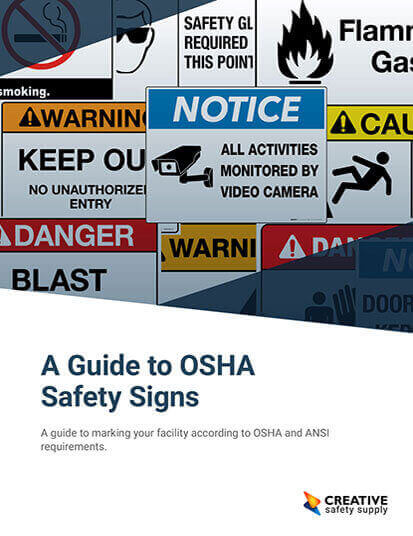
In many industries, workers are constantly surrounded by hazards, and in many cases, it's unavoidable due to the sort of work they're doing. To keep these workers safe, it's crucial that they be presented with constant reminders and helpful guidance on where hazards are located and how to safely avoid them. When it comes to designing a hazard warning, there are two crucial rules that must always be considered:
- The warning has to be immediately evident. While a detailed paragraph explaining the hazard would offer a more thorough warning, reading all that text would waste valuable time -- time people may not have during an emergency.
- The warning cannot be restricted by language barriers. There's no guarantee that the people viewing your hazard warning will speak your language, or even that they'll all speak the same language. Your warning should be designed to protect anyone, no matter which language they speak.
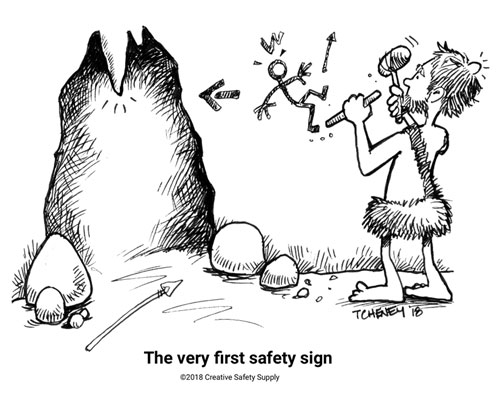
These two critical tenets rule out most of our common methods of conveying information en masse, but there's one very old, very basic communication option remaining that's both universally understood and immediately accessible: The pictogram.
First used by our cave-dwelling ancestors to depict crucial information such as the location of food and which animals are especially mean, pictograms are the perfect vehicle for conveying warnings. They're simple, easily deployed in any environment, and, when designed correctly, pictograms can be recognized and convey meaning to anyone, of any age, anywhere in the world. As that's exactly what you'd want from a warning system designed to keep people informed in life and death situations, OSHA recommends the use of hazard pictograms on every hazard warning.
Nine Vital Chemical Safety Symbols
While there are numerous pictograms to be found throughout the modern workplace -- particularly if that workplace deals in caustic chemicals -- the recently-adopted Globally Harmonized System of Classification and Labeling of Chemicals relies on nine core hazard pictograms which we'll explore below.
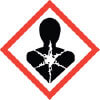
Health Hazard: This pictogram indicates a substance that presents a health hazard when inhaled, has high carcinogenicity or mutagenicity, and/or directly damages one or more organs.
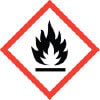
Flame: The flame pictogram indicates a substance that is flammable. This includes common flammable substances such as gasoline, but also includes liquids and solids that burst into flame when in contact with air and water, and mixtures with the potential to self-heat and spontaneously ignite.
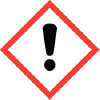
Exclamation Point: That exclamation point is designed to get your attention quickly, because it indicates a hazard that is acutely toxic. Acutely toxic substances cause damage quickly, can be absorbed in numerous ways (including respiration and skin contact), and can cause damage to eyes, skin, and internal organs with even minute exposure.
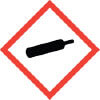
Gas Cylinder: This pictogram indicates that gas under pressure. This includes compressed gases, liquified gases, and gases that have been dissolved. Any container with contents that are under immense amount of pressure should be handled with care. Some even require specific storage and transportation protocols, so it's important to be know and abide by them for your safety and the safety of others.
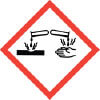
Corrosion: Exactly what the name would suggest, this pictogram indicates substances that corrode metal or flesh. Needless to say, these substances can cause serious eye, skin, or other tissue damage. If contact with corrosive substances does occur, emergency personnel should be notified immediately so that damage and long-term consequences can be minimized.
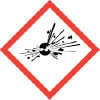
Exploding Bomb: The exploding bomb pictogram commonly indicates explosives, but it also includes substances and mixtures that are self-reactive, which can react explosively to even the most minor of physical shocks, or even a slight increase in air pressure. In any case, it's always a good idea to take extra precautions when this pictogram is present.

Flame Over Circle: This pictogram represents gases or liquids that oxidize, or lose electrons. This seems like a minor concern compared to, say, explosives, but the oxidization process can completely transform a substance. Hydrogen gas, for instance, quickly becomes water when oxidized -- that's great news for thirsty people, but bad news for anyone hoping to use that hydrogen for its many industrial purposes.
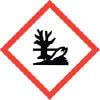
Environmental: As the dead fish suggests, this pictogram indicates that a substance poses a hazard to the aquatic environment, and should not be allowed to reach lakes, streams, or groundwater. This can include both acute hazards which will immediately cause massive damage to the ecosystem, as well as chronic hazards which can destroy an ecosystem for years or decades to come.
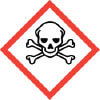
Skull and Crossbones: The skull and crossbones pictogram serves as a warning against substances that are acutely toxic. These are substances that can cause significant damage with very limited exposure, such as a single dose absorbed orally or through the skin. Effects of acutely toxic substances range from skin lesions, to respiratory difficulties, all the way up to death.
Additional GHS facts:
- GHS pictograms are symbols that represent different types of hazards, such as health, physical, and environmental, for chemical substances and mixtures. They are part of the Globally Harmonized System of Classification and Labelling of Chemicals (GHS), which aims to harmonize the criteria and communication elements for hazardous chemicals worldwide. Source: https://en.wikipedia.org/wiki/GHS_hazard_pictograms
- There are nine GHS pictograms in total, each with a distinctive shape and color. The pictograms are: exploding bomb, flame, flame over circle (oxidization), gas cylinder, corrosion, skull and crossbones (acute toxicity), health hazard, environmental hazard, and exclamation point. Each pictogram may have one or more corresponding hazard statements, which describe the nature and degree of the risk posed by the chemical. Source: https://unece.org/transport/dangerous-goods/ghs-pictograms
- GHS pictograms are used for the labelling of containers and for workplace hazard warnings, as well as for the transport of dangerous goods. However, the pictograms for transport have some differences from the pictograms for other sectors, such as the use of different colors, the inclusion of a subcategory number, or the omission of certain symbols. Source: https://en.wikipedia.org/wiki/GHS_hazard_pictograms
- GHS pictograms are one of the key elements for the implementation of OSHA’s Hazard Communication Standard (HCS), which requires employers to provide information and training on the hazards and safe use of chemicals to their workers. The HCS was aligned with the GHS in 2012, and the compliance deadline for the use of GHS pictograms was June 1, 2016. Source: https://www.osha.com/blog/ghs-hazard-signs
- GHS pictograms can help workers and consumers to identify and handle hazardous chemicals safely and effectively. They can also facilitate the trade and transport of chemicals across borders, by reducing the need for multiple labels and simplifying the communication of hazards. Source: https://unece.org/transport/dangerous-goods/ghs-pictograms
Similar Articles
- What is HAZCOM? (Hazard Communication Definition + OSHA Standards)
- Job Hazard Analysis: Addressing Coronavirus Risk in Your Workplace
- Hazard and Operability (HAZOP Analysis)
- GHS Label Information
- GHS: The Globally Harmonized System for Labeling [Updated 2019]
- GHS Label Creation
- Understanding the NFPA 704 Diamond Labeling System
- Safety Data Sheets (SDS)
- Safety Colors (OSHA Guidelines and Color Codes)

